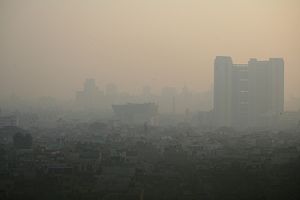November 2016 has been particularly bad for New Delhi in terms of its general air quality, with high levels of smoke, low visibility, and dangerous levels of air pollution. Some days last month were recorded as the worst in 10 years. After the festival of Diwali earlier this month, PM 2.5 levels — the concentration of tiny pollutive and disease inducing particles within the air — soared to record highs. While initially there was suspicion that this was a direct result of the bursting of firecrackers that accompanies the festival, a pollution heat map released by the World Health Organization (WHO) earlier this year placed New Delhi as the 11th most polluted city in the world, indicating a more deep-seated problem.
The Central Pollution Control Board (CPCB) pegged the increase in pollutants to a drop in mean wind speeds and a reversal in the normal wind direction. While the WHO has recommended that these levels be contained to below 10 on an annual average, the rates went up to 119 in 2015 for the city. In the context of the events of this November, the risk of contracting respiratory diseases has been on a steady increase, on days visibility went to below 50 meters and the smog does not seem to be letting up. Regularly updated indices of air pollution have become a constant source of information for concerned citizens, as a lack of a reliable centralized system has been widely noted.
For weeks in November, interim measures were taken by the government. Schools and construction work-sites were closed for a while, as was the Badarpur Thermal Power Station. Stricter laws regarding garbage disposal — particularly the burning of leaves — were implemented and landfill based fires were put to an end. Preparations to re-introduce the odd-even rule (which monitored which vehicles with which license plate numbers could play the road on particular days) are being discussed and there has also been discussion regarding the possibility of creating artificial rain to bring down dust levels.
Companies and business operations have taken a hit as well, with some offering bus services to cut down on vehicular pollution from multiple cars, and others allowing employees to work from home for a while. Tour operators have reported a hit in their seasonal opportunities due to weather-induced cancellations. Face-mask sales have risen exponentially compared to previous years, with some companies importing emergency supplies to meet the scrambling demand.
The government has received censure and instructions from multiple ends. The National Green Tribunal has instructed it to set up both central and state level monitoring committees to prepare action plans regarding pollution and also suggested a ban on diesel vehicles older than ten years. The Supreme Court has further chastised the government for not implementing these measures properly – identifying just three air ambiance monitoring stations and no adequate central system to collate the real-time data to provide information to the citizens. UNICEF put out a statement declaring Delhi to be a wake-up call for the rest of the world, and stressed the importance of adequate pollution monitoring and mitigation, while also discussing the risks of trans-boundary pollution.
The CPCB has been meeting with the state pollution control boards in order to create a more integrated system to manage pollution levels and avoid overlapping work on the part of the multiple agencies that will be aiming to tackle a problem of this proportion across the country, with Delhi as a warning. On November 28, authorities announced 20 monitoring stations to exclusively measure the most dominant pollutants, amid much skepticism at both the pace and commitment of the government over the weeks prior to this. Calls for better transparency and forecasting have been consistent since the post-Diwali crisis. With the predicted drop in temperature for the first week of December for Delhi, there are worries that a further reduction in wind speed looms large. It is imperative that the outcomes of all the discussions and meetings taken up over this emergency period be implemented at a much faster and more consistent pace if respite is to be provided to India’s choking capital city.

































